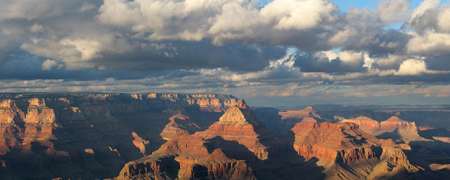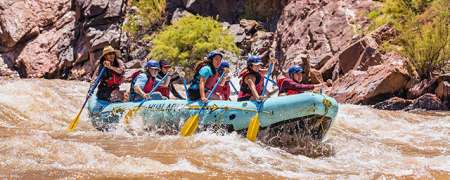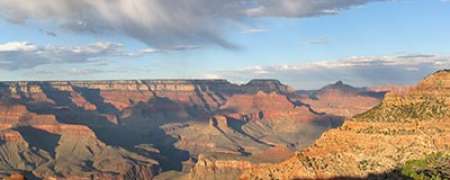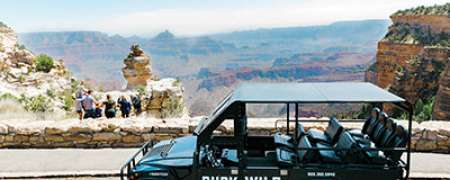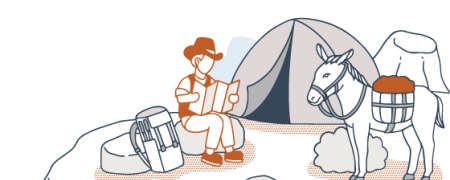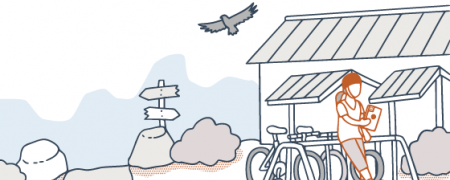Self-Guided Itinerary Details
Day 1 Grand Canyon's South Rim:
The best locations to begin this road trip from are Flagstaff, Williams, Tusayan or Grand Canyon Village (South Rim). Once you're on the road and ready to explore, you can begin this itinerary from either the South Entrance station and head toward Desert View or you can start at the East Entrance station and head toward Grand Canyon Village.
- We’ll assume that you’re entering from the South Entrance where you will then follow signs and park at the Grand Canyon Visitor Center. A short walk will take you to the first breathtaking view of the canyon at Mather Point.
- From there, you can either choose to walk along the easy, paved Rim Trail (.7 miles) or take the park’s free Orange/Kaibab shuttle bus to the Yavapai Geology Museum. Yavapai Geology Museum includes in-depth exhibits about how Grand Canyon formed, but most people just marvel at the view through the incredible windows that look right down at the bottom of the canyon. Looks closely and you’ll be able to spot two small glimpses of the Colorado River below you.
- From the museum, hop onto the park’s free Orange/Kaibab shuttle bus and explore the other canyon overlooks including Pipe Creek Vista, South Kaibab Trailhead and Yaki Point.
- Hop back in your car and head east along Hwy 64/Desert View Drive. Keep a close eye on the mile makers and a little past mile marker 246 you’ll see a small dirt parking lot on the left side of the road with a locked metal gate that leads down an old dirt road. This is the unmarked trailhead to Shoshone Point, one of the best views of Grand Canyon and well worth the flat and east 2-mile hike that it requires. This is great place to escape the crowds and have a relaxing few minutes to yourself.
- Once you’re done hiking, continue to drive east. Honestly, you’ll want to stop at all of the signed overlooks including Grandview Point, Moran Point, Lipan Point and Navajo Point. If you have enough time, you will also want to check out the Tusayan Ruins and Museum, where you’ll see the ancient stone ruins of the ancestral Puebloan people who inhabited Grand Canyon hundreds of years ago.
- The last stop is at the world-famous Desert View Watchtower, perhaps architect Mary Jane Colter’s best masterpiece sitting at the edge if Grand Canyon. Soaring 70 feet above the canyon rim, you can ascend the watch tower stairs and enjoy incredible paintings by famous Hopi artist Fred Kabotie throughout the different levels. Standing at the top of the watch tower, you’ll look down at a large expanse of the Colorado River below you as well as a vast view of the Painted Desert and the Navajo Indian Reservation to the east. If you can time seeing sunset at Desert View, you’ll certainly be glad that you did!
Grand Canyon's South Rim Day 2:
Day two of the road trip will give you time to explore Grand Canyon Village and the park’s famous scenic overlooks along Hermit Road. Start your day in Grand Canyon Village, and if you can, enjoy a breakfast in the El Tovar dining room. The views of the canyon, the warm fireplaces and classic southwest décor make it a great place for a meal, in addition to their great menu items like breakfast burritos and house made pastries.
- Explore Grand Canyon Village on foot including Verkamp’s Visitor Center, Bright Angel Lodge, and Kolb and Lookout Studios.
- At the end of the Village, a short walk on the rim trail past Kolb Studio, you’ll come across the Bright Angel Trailhead. One of Grand Canyon’s most famous trails, Bright Angel Trail descends all the way to the bottom of Grand Canyon. If you want to experience just a short trip below the rim, walk down the trail to the tunnel first or second tunnels for a great photo op. If you have more time and more energy, explore as far as the 1.5 mile Resthouse (3 miles troundtrip). The resthouse offers pit toilets and a seasonal water refill station to fill your water bottles for the hike back to the top.
- Just a little west of the Bright Angel Trailhead you’ll find the first bus stop on the park’s free Red/Hermit route. The Hermit Road extends for 8 miles west of Grand Canyon Village and offers some of the most famous views of the canyon along the way. The Rim Trail also parallels the road and canyon for the entire 8 miles so you can choose to use a combination of shuttle bus and walking to explore the canyon as you wish.
There are numerous stops along Hermit Road and you will enjoy them all if you have time to get out at each stop. Highlights include:
- Maricopa Point: The former site of the Orphan Mine, where uranium was once mined at the canyon. The mine the mine ran until it passed to the National Park Service in 1987 and the mining structure was removed in the 2007.
- Powell Point: Offers you a raised platform that hosts a monument to John Wesley Powell, the first man to raft through Grand Canyon. A one-armed veteran of the Civil War, he rafted into the unknown and somehow came out alive, but barely.
- Hopi Point: One of the most scenic and biggest east-west views of the canyon. Great but very crowded spot for sunset. Look for California condors soaring overhead.
- The Abyss: The largest straight down drop on the South Rim.
- Pima Point: Another great sunset spot and if it’s really quiet, you can hear the rapids of the Colorado River roaring below you.
- Hermits Rest: One of architect Mary Jane Colter’s structures, Hermits Rest sits at the edge if the canyon and has an impressive floor to ceiling fireplace. There are restrooms, water refill stations and a small gift and snack shop.
Return on the free shuttle to Grand Canyon Village an on to your next Grand Canyon destination!
